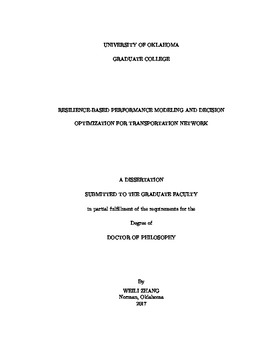| dc.description.abstract | The economy and social well-being of a community heavily rely on the availability
and functionality of its critical infrastructure systems, including power, water, gas,
and transportation. Roadway networks are a fundamental component of
transportation systems and, in the event of an extreme hazard, play a critical role
during and after the event. Consequently, quantifying the performance of
transportation infrastructures and optimizing decisions to mitigate, prepare for,
respond to, and recover from the potential hazards. This research presented a
novel resilience-based framework to support resilience planning regarding
pre-disaster mitigation and post-disaster recovery. First, the author
proposes a new performance metric for transportation network,
weighted number of independent pathways (WIPW), integrating the
network topology, redundancy level, traffic patterns, structural reliability of
network components, and functionality of the network during community’s
post-disaster recovery in a systematical way. To the best of our knowledge,
WIPW is the only performance metric that permits risk mitigation alternatives
for improving transportation network resilience to be compared on a
common basis. Based on the WIPW, a decision methodology of prioritizing
transportation network retrofit projects is developed.
Second, our studies extend from pre-disaster mitigation to post-hazard recovery, i
in which this research presents two metrics to evaluate the restoration over
the horizon after disasters . That is, total recovery time and the skew of the
recovery trajectory. Both metrics are involved in the multi-objective stochastic
optimization problem of restoration scheduling. The metrics provided a new
dimension to evaluate the relative efficiency of alternative network recovery
strategies. The author then develops a restoration scheduling methodology for
network post-disaster recovery that minimizes the overall network recovery
time and optimizes the recovery trajectory, which ultimately will reduce economic
losses due to network service disruption. The WIPW, pre-disaster
mitigation, and post-disaster recovery are illustrated in the same hypothetical
bridge network with 30 nodes and 37 bridges subjected to a scenario seismic
event. Finally, a comprehensive stage-wise decision framework is introduced. The
entire resilience planning is separated into three stages, pre-disaster mitigation,
post-disaster emergency response, and long-term recovery. The WIPW
is decomposed to three specific decision metrics to measure the performance of
a network regarding robustness, redundancy, and recoverability, respectively.
Decision support models for mitigation and recovery developed in the previous
studies are revised to accommodate the stage-wise metrics. The proposed
stage-wise framework is applied to a real-world roadway network of Shelby
County, TN, USA subjected to seismic hazards. | en_US |
